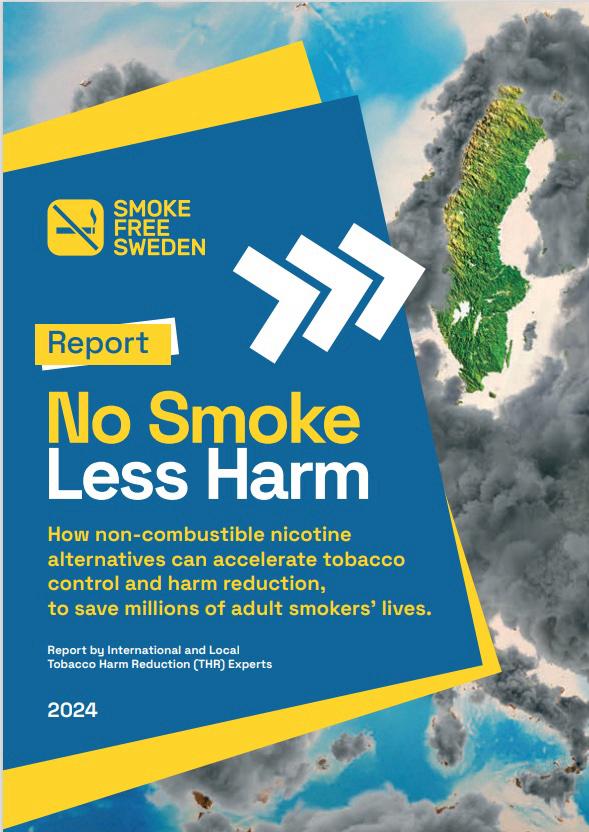
Image from the Smoke Free Sweden movement
MANILA, Philippines — Sweden’s adoption of smokeless tobacco products has dramatically reduced smoking rates and related diseases, putting the country on the verge of becoming the first to achieve smoke-free status, according to a landmark report.
The “No Smoke Less Harm” report released in Stockholm by global health advocacy group Smoke Free Sweden noted that the country is on track to become the first smoke-free European nation, with a smoking rate below 5 percent. It attributed this achievement to Sweden’s openness to alternative nicotine products and adoption of tobacco harm reduction.
The report credited the low rate of smoking-related diseases to Swedes’ preference for alternative smokeless tobacco products like snus, oral nicotine pouches, heated tobacco products, and vapes, which are less harmful than smoking. This shift, the report says, has led to a “smoke-free generation.” ZYN, the most popular oral nicotine pouch in the US, originated from Sweden.
READ: PH asked to follow UK approach in reducing smoking rate
The report concluded that high nicotine use does not lead to high rates of health problems, presenting compelling evidence that despite similar levels of nicotine consumption, Sweden has significantly lower rates of tobacco-related diseases compared with other European nations.
Dr. Karl Fagerström, a public health expert who contributed to the report, said the distinction between smoking and smokeless products is crucial.
“While nicotine is addictive, it does not cause the serious diseases associated with smoking,” Fagerström said. “Our findings support a shift in focus from cessation to substitution with less harmful alternatives for those unable to quit completely.”
Nearly one in four adults in Sweden use nicotine daily, which is on par with European averages. However, Sweden has far fewer tobacco-related deaths (44 percent lower), cancer rates (41 percent lower), and cancer deaths (38 percent lower) compared to the rest of the European Union.
Comparisons using 2020 data for men only show even starker differences. Sweden has 52 percent fewer tobacco-related male deaths than Poland and 57 percent fewer than Romania. For male lung cancer, Sweden has significantly fewer deaths than France, Germany, Italy, and Poland.
Sweden’s public health agency reported that only 5.6 percent of Swedish adults smoked cigarettes in 2022, down from 49 percent of men in 1960.
Dr. Scott Gottlieb, a former commissioner of the US FDA, recognized the benefits of smoke-free products. He said in a recent interview over CNBC that, “If we can convert more currently addicted adult smokers onto these modified risk products (ZYN nicotine pouches) that don’t have all the harms associated with combustion, we can achieve a substantial net public health benefit.”
The report argues that the method of nicotine consumption has a significant impact on health outcomes. While smoking is linked to high rates of death and disease, the report finds smokeless alternatives, like snus and oral nicotine pouches, don’t pose a similar health risk.
Sweden’s public health policies and regulations have encouraged the transition to smokeless products, according to the report. It suggests other countries could adopt similar harm reduction strategies to reduce tobacco-related health problems.
“The Swedish experience demonstrates that understanding public misperceptions about nicotine can lead to health policies that better protect and inform consumers,” Fagerström said.
The report echoes the National Health Service’s (NHS) stance that nicotine, while addictive, is relatively harmless to health and suggests comparing the dependence levels of nicotine and caffeine to create risk-based regulations for both substances.
Smoke Free Sweden is a movement that advocates for other countries to follow Sweden’s lead in tobacco harm reduction. The report appeals for the World Health Organization (WHO) and global public health communities to acknowledge that combustible products, not nicotine itself, cause harm to smokers. It highlights the existence of significantly less risky forms of nicotine consumption.
It urges policymakers to recognize the potential of tobacco harm reduction (THR) in reducing harm, regulate nicotine products based on their relative risk profile, encourage healthcare professionals to embrace THR as a harm reduction strategy, and empower THR users to advocate for supportive policies.